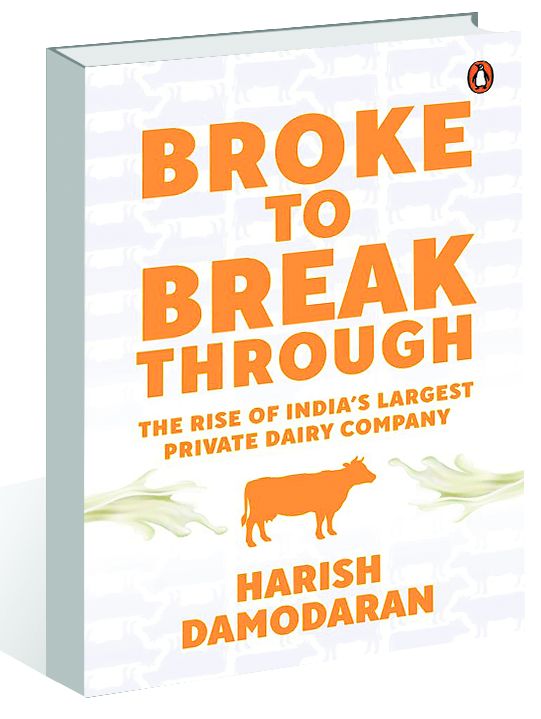Broke to Breakthrough by . Penguin Random House. Pages 244. Rs599
Book Title: Broke to Breakthrough
Author: Harish Damodaran
Varun Roojam
“Broke to Breakthrough” is an unusual title for a book, but so is the story of RG Chandramogan and the company, Hatsun Agro Products Limited (HAP), which he had founded in 1970. The author, Harish Damodaran, a well-known writer on agriculture with a deep understanding of the subject, gives a riveting account of the journey of India’s largest private dairy company. How it went through tough situations and at times was on the verge of bankruptcy, but the vision and commitment of the owner saw him pull through these challenges.
The book is divided into seven chapters, which are interwoven organically and trace the growth of an ice-candy manufacturer with a capital of Rs13,000 to a company with a turnover of Rs5,500 crore. The virtues of thrift and managing with little resources were embedded in Chandramogan’s formative years, while living in his village with his parents and grandparents. He left his studies midway and started working with a timber merchant, where his managerial and financial skills were noticed and appreciated. As he wanted to do something big in life, he invested a small amount to set up an ice-candy unit under the ‘Arun’ brand on a 250 square feet space belonging to an uncle.
The book captures the various phases of struggle during his initial years and how he ventured into a side business of selling aluminum cans, exiting it later to concentrate on fresh marketing and franchisee models for his primary passion. He entered unexplored small-town markets and set up exclusive Arun ice-cream parlours, which was a totally new concept then.
It was a matter of time that Arun ice cream became a leading brand in Tamil Nadu. The author recounts that soon, Chandramogan realised that his future lay in milk and related businesses, so he set up a company and invested heavily in a milk plant.
His initial product, ‘Santosa’ (milk-shake powder), launched in 1992, failed, resulting in huge financial stress. Chandramogan, however, was not bogged down, and with his steely resolve re-strategised and ventured into liquid milk business. ‘Arokya’ had 4.5 per cent fat as compared to the TN cooperative federation’s ‘Avni’ brand, which had 3 per cent. He was sure that housewives won’t mind paying a rupee extra. As it came about, the product was a huge success.
The transition from ice cream to dairy business and its expansion is narrated in an interesting manner. Chandramogan’s trials and tribulations, whether dealing with the archaic laws or investing heavily in modern technologies, have been covered extensively.
Private-sector dairy business is one of the most challenging sectors where few businessmen dare to venture because of its multiple challenges of supply chain, and the perishable nature of the commodity. Also, this sector has been dominated by public-sector milk federations, where the likes of Amul, Verka, Mother Dairy, Vita, etc, are the market leaders. The state governments increase the price of milk procurement in the interest of farmers, which has a rippling effect on the whole milk industry. The author touches upon this topic eloquently and narrates the resilience of Chandramogan and his deep understanding of the milk business.
The way Hatsun invested heavily in marketing and overhauled the super-stockist and distributor-retailer chain is a good lesson for young entrepreneurs. In those days, Hatsun engaged American marketing guru Al Ries and his team, known for the concept of brand positioning. Those ideas were pathbreaking and catapulted Hatsun into a different orbit.
The author illustrates lucidly how Chandramogan took the road less travelled, adopting best practices from advanced countries like New Zealand by engaging the farmers directly. The entrepreneur knew that the key to success was to reduce the cost of milk production, increase his savings and put back more money into the farmers’ pockets. For this purpose, Hatsun invested in high-tech cattle-feed plants and adopted the ‘White Gold’ project under which milk procurement from farmers was made tech-friendly.
This made the process of procurement transparent, reduced malpractices and increased the trust of farmers. The company motivated them to adopt best practices like cultivating high-quality fodder and created the concept of milk banks in villages.
The book also explores the topic of direct bank transfers into farmers’ accounts and how the company was able to tide over the crisis of demonetisation in 2016 by adopting this practice very early. Covid-19 came as a big disruption, but here again, the team’s persistence ensured the company bounced back.
An enchanting read, the book is highly recommended for students of business schools and all those who believe in their convictions.














